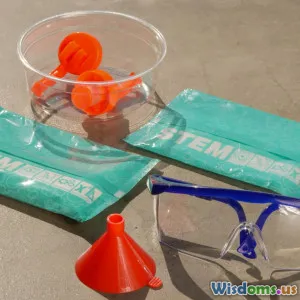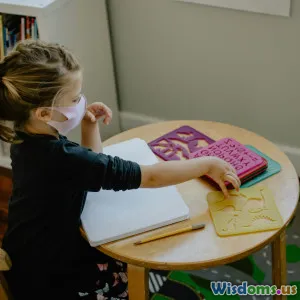
Cooking with Science: What Can Kids Learn from DIY Labs?
9 min read Explore how DIY science-inspired cooking labs teach kids critical thinking, creativity, and real-world science through hands-on fun. (0 Reviews)
Cooking with Science: What Can Kids Learn from DIY Labs?
Imagine a kitchen buzzing with bubbling potions, colorful reactions, and lively debates over why bread rises or how chocolate melts. For many children, this picture represents not just a place to eat, but a dynamic laboratory where scientific principles come alive through cooking. DIY science cooking labs are emerging as an exciting approach to education, combining the art of handmade creations with the rigor of science. But what exactly can kids learn from this intersection of culinary arts and science? Let's embark on a flavorful journey uncovering how DIY cooking labs cultivate curiosity, critical thinking, and scientific understanding in children.
Introduction: The Kitchen as a STEM Playground
Traditional education often struggles to make science accessible and engaging for young learners. Complex theory and abstract concepts risk losing their real-world context. Yet, cooking — something most children experience daily — is a treasure trove of scientific phenomena. From Maillard reactions browning a steak to fermentation producing the fizzy charm of kombucha, cooking is hands-on chemistry, physics, and biology.
DIY laboratories tailor this curiosity-driven approach into safe, manageable experiments. They encourage kids to ask "why" while whisking, "how" while heating, and "what if" while mixing. The impact goes beyond mastering recipes; it nurtures skills central to scientific inquiry and creativity. But what elements make DIY cooking labs particularly effective educational tools?
Body
1. Learning Scientific Concepts Through Cooking
Chemistry in Action
Cooking is, at its core, chemistry in the kitchen. Consider the classic example of baking a cake. Kids learn about chemical leavening agents like baking soda and baking powder that release carbon dioxide, causing the batter to rise. When a lemonade turns cloudy after adding sugar, they witness crystallization and supersaturation firsthand.
In DIY labs, children can conduct controlled experiments — for example, altering ingredient ratios to observe how texture and taste change. This direct manipulation helps demystify abstract chemical reactions. The National Science Foundation highlights that this form of experiential STEM learning leads to deeper understanding. For example, a study published in the Journal of Chemical Education found that cooking-based experiments increased comprehension of acid-base reactions among middle schoolers.
Physics at Play
From heat transfer mechanisms to the properties of water, cooking underscores key physics concepts. Explaining how conduction works when a pan heats can help children grasp energy transfer. The fascinating process of emulsification — such as when oil and water mix using egg yolks in mayonnaise — allows discussion of molecular polarity and surface tension.
DIY labs enable practical demonstrations of these physics principles. When kids experiment with cooking methods (boiling vs. steaming vs. frying), they observe differences in heat application and flavor outcome.
Biological Sciences Unveiled
Enzymatic browning, yeast fermentation, and even nutrition science can be explored through cooking. Fermentation in sourdough bread or kimchi introduces microbiology by showing how microorganisms transform food.
The DIY setup encourages kids to care for live cultures and observe changes over days or weeks — fostering understanding of life cycles and ecosystems. Nutrition lessons embed smoothly here, making kids inquisitive about food’s effect on the human body.
2. Critical Thinking and Problem Solving Skills
Science thrives on questioning and hypothesis testing — a core value in DIY labs. For example, when a cookie batch comes out too hard or a sauce splits, children learn problem-solving techniques by evaluating variables such as temperature, ingredient quality, or mixing strategy.
Encouraging children to document experiments — noting what worked and what didn’t — builds scientific literacy. It mirrors the processes followed in professional laboratories and teaches resilience: "Failure" becomes a learning step, not a setback.
3. Creativity and Innovation
DIY cooking labs also foster creativity. Children can invent new flavor combinations, texture contrasts, or presentation styles. More importantly, they learn to innovate by tweaking traditional recipes, understanding substitutions, or creating food for special dietary needs.
Real-world innovators have leveraged this mindset extensively. The famous food scientist Hervé This, often called the ‘father of molecular gastronomy,’ popularized unveiling culinary mysteries through science, inspiring many young learners worldwide to see cooking as experimental art.
4. Building Confidence Through Hands-On Experience
Practical participation in cooking experiments builds children's confidence in their abilities to control processes and outcomes. A Cornell University study indicated that children involved in kitchen tasks showed improved self-esteem and academic skills.
DIY labs provide a safe environment where making mistakes is a vital part of growth. Celebrating small successes, such as mastering whipped cream or making homemade butter, offers tangible proof of their competence or learning progress.
5. Social and Emotional Learning Through Collaboration
Many DIY laboratory projects encourage group work, nurturing communication and teamwork skills. Planning, sharing tasks, and discussing observations help children develop empathy and cooperation — skills essential beyond science or cooking.
Conclusion: Empowering Future Thinkers and Makers
DIY science cooking labs do more than just teach kids how to cook; they open doors to critical scientific thinking, creativity, and self-confidence. By merging everyday kitchen fun with rich scientific exploration, children learn complex concepts naturally and joyfully. They grasp that science is not confined to labs or textbooks but is integral to daily life.
Parents, educators, and community leaders can harness this approach to ignite lifelong STEM curiosity. Practical projects, like experimenting with caramelization or creating natural color indicators from red cabbage, exemplify how science education doesn’t need complicated equipment or strict labs — just curiosity, safety, and some homemade spirit.
In embracing DIY cooking science, kids not only become better cooks but grow into keen observers, innovative thinkers, and confident creators. This recipe for learning serves ingredients for success far beyond the kitchen.
Quick Starter Ideas for Your Own DIY Cooking Lab
- Magic Milk Experiment: Using milk, food coloring, and dish soap to explore surface tension.
- Yeast and Sugar Rises: Mix yeast with sugar water to watch fermentation in action.
- Breadcrumb Engineering: Test moisture retention in different types of bread.
- Edible pH Indicators: Extract red cabbage juice and test acidity of various kitchen substances.
Harness these simple but powerful activities to unlock the tasty science all around!
References
- National Science Foundation: STEM Activity Guides
- Journal of Chemical Education, Cooking as a Tool for Teaching Chemistry
- Cornell University Children and Cooking Study
- Hervé This: Molecular Gastronomy Insights
Embark on the fun-filled scientific adventure in your kitchen today!
Rate the Post
User Reviews
Popular Posts





















